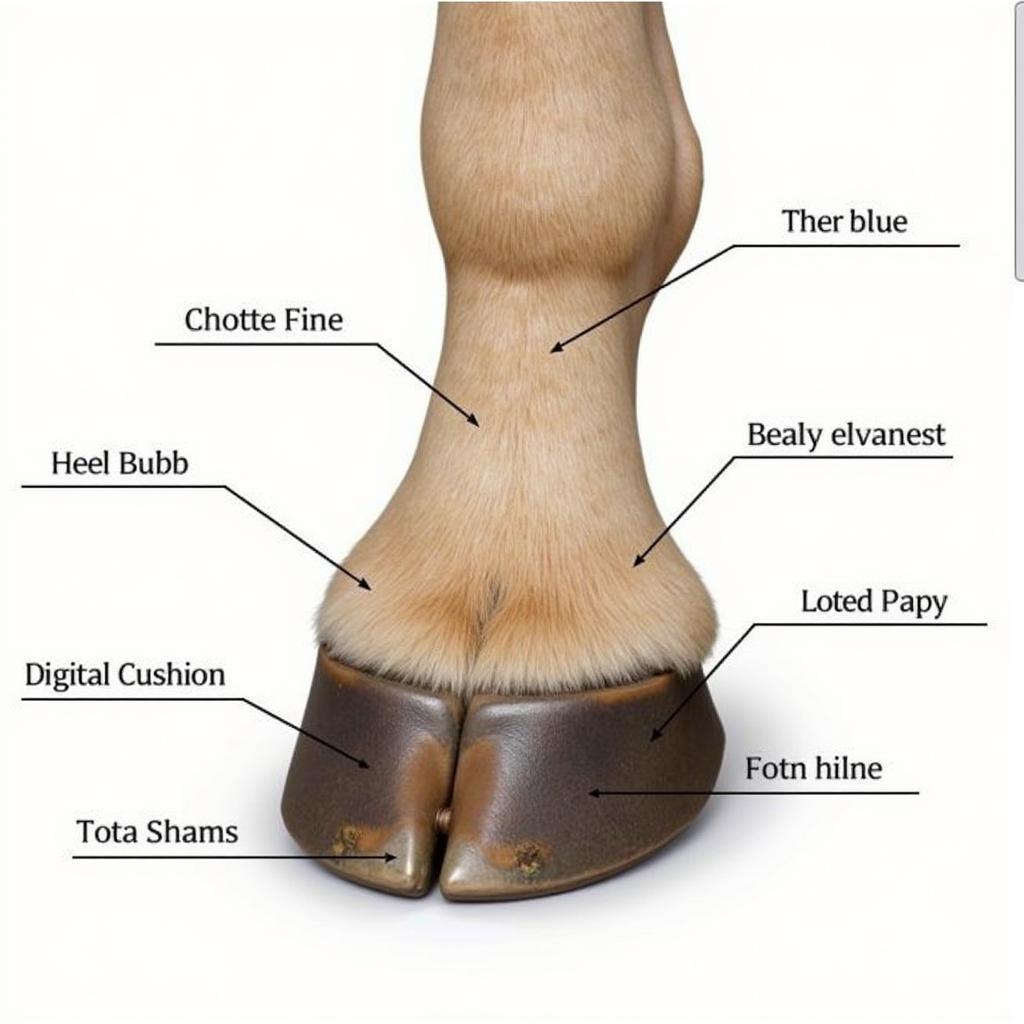The Horse Heel Bulb, a crucial part of your horse’s hoof, acts as a natural shock absorber and plays a vital role in overall soundness. Understanding its structure and function is essential for providing optimal horse care and preventing potential problems. This article will delve into the anatomy of the horse heel bulb, common issues that can arise, and preventative measures you can take to keep your horse’s hooves healthy.
Anatomy and Function of the Horse Heel Bulb
The heel bulb is the rounded, fleshy part of the hoof located at the back of the heel. It covers the sensitive digital cushion, a fatty tissue structure that absorbs concussion and protects the internal structures of the foot. The heel bulb produces a waxy substance that helps maintain hoof moisture and protects against bacterial and fungal infections. A healthy heel bulb should be smooth, firm, and free from cracks, wounds, or swelling.
 Horse Heel Bulb Anatomy
Horse Heel Bulb Anatomy
Common Horse Heel Bulb Problems
Several issues can affect the horse heel bulb, often caused by environmental factors, poor hoof care, or underlying medical conditions. Some common problems include:
- Cracks: Dry conditions, trauma, or infections can lead to cracks in the heel bulb. These cracks can be painful and can become entry points for bacteria, leading to further complications.
- Thrush: This bacterial infection thrives in moist, unsanitary environments and can cause a foul odor, black discharge, and erosion of the frog and heel bulb.
- Canker: A more severe infection than thrush, canker affects the deeper tissues of the hoof, including the heel bulb, causing chronic inflammation and lameness.
- Greasy Heel: Also known as “mud fever,” greasy heel is a skin inflammation often triggered by prolonged exposure to wet and muddy conditions. It affects the lower limbs, including the heel bulbs, causing scabbing, hair loss, and discomfort. Proper care and the right horses boot can prevent this.
- Scratches: Similar to greasy heel, scratches are a bacterial skin infection that can affect the heel bulbs, causing pain, swelling, and discharge.
Identifying Heel Bulb Issues: What to Look For
Knowing the signs of heel bulb problems is crucial for early intervention and effective treatment. Be vigilant for any changes in your horse’s hooves, including:
- Swelling or inflammation
- Heat or pain to the touch
- Discharge or foul odor
- Cracks or lesions
- Lameness or reluctance to bear weight
Preventing Heel Bulb Problems
Maintaining healthy heel bulbs requires diligent hoof care and management. Here are some preventative measures to consider:
- Regular Hoof Cleaning: Pick out your horse’s hooves daily to remove dirt, debris, and manure.
- Proper Trimming and Shoeing: Ensure your farrier trims and shoes your horse’s hooves regularly, maintaining a balanced and healthy hoof shape. Sometimes, horse heel bulb peeling is necessary as part of treatment.
- Dry and Clean Environment: Provide a clean and dry environment for your horse, especially in stalls and paddocks. Avoid prolonged exposure to wet and muddy conditions. Using kombat boots for horses can be helpful.
- Regular Hoof Inspections: Inspect your horse’s hooves regularly for any signs of abnormalities.
- Balanced Diet: A balanced diet rich in essential nutrients supports healthy hoof growth and overall well-being.
“A proactive approach to hoof care is the best way to prevent heel bulb problems and ensure your horse’s long-term soundness,” advises Dr. Amelia Shepherd, DVM, specializing in equine podiatry.
Treatment Options for Heel Bulb Issues
Treatment for heel bulb problems varies depending on the underlying cause and severity of the condition. Consult with your veterinarian for a proper diagnosis and treatment plan. They may recommend topical medications, systemic antibiotics, or other interventions. They may also suggest easy boots for horses sizes. “Early intervention is key to successful treatment and minimizing long-term complications,” emphasizes Dr. Shepherd.
Conclusion
The horse heel bulb is a vital structure that requires regular care and attention. Understanding the anatomy, common problems, and preventative measures can help you maintain the health and soundness of your horse’s hooves. By following the recommendations in this article, you can proactively address potential issues and ensure your horse’s comfort and well-being. Remember, proper hoof care is an essential part of responsible horse ownership. Are you noticing any issues with your horse’s heel bulbs?
FAQ
- How often should I clean my horse’s hooves?
- What are the signs of thrush in horses?
- How can I prevent greasy heel in my horse?
- When should I call a veterinarian for a heel bulb problem?
- What is the role of the digital cushion in the horse’s hoof?
- Can draft horse bell boots help protect the heel bulb?
- What are some common treatments for heel bulb cracks?
Common Scenarios
- Scenario 1: Your horse has developed a small crack in one heel bulb.
- Scenario 2: You notice a foul odor and black discharge around your horse’s frog and heel bulbs.
- Scenario 3: Your horse is exhibiting lameness and sensitivity in one hind leg, and you notice swelling around the heel bulb.
Further Reading
- Article on hoof anatomy and physiology
- Blog post on common hoof problems
- Research paper on the effects of environment on hoof health
When you need assistance, please contact Phone Number: 0772127271, Email: [email protected] Or visit our address: QGM2+WX2, Vị Trung, Vị Thuỷ, Hậu Giang, Việt Nam. We have a 24/7 customer service team.